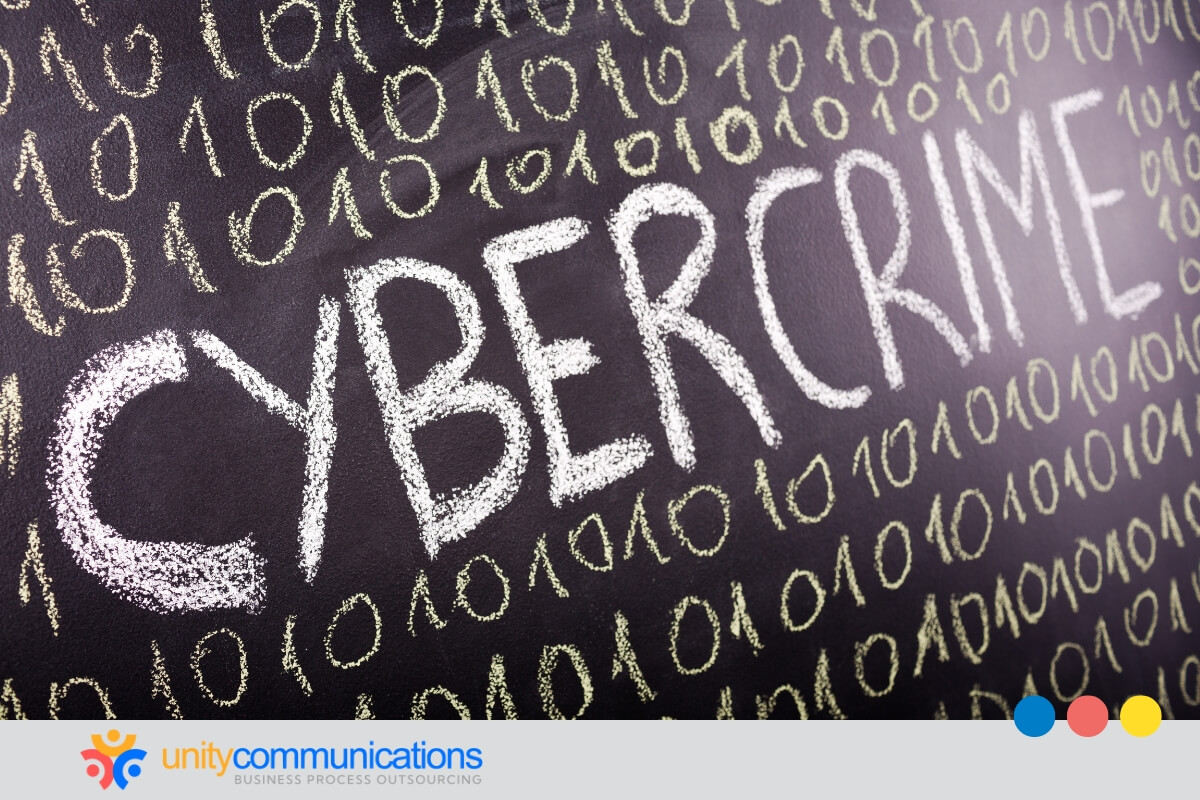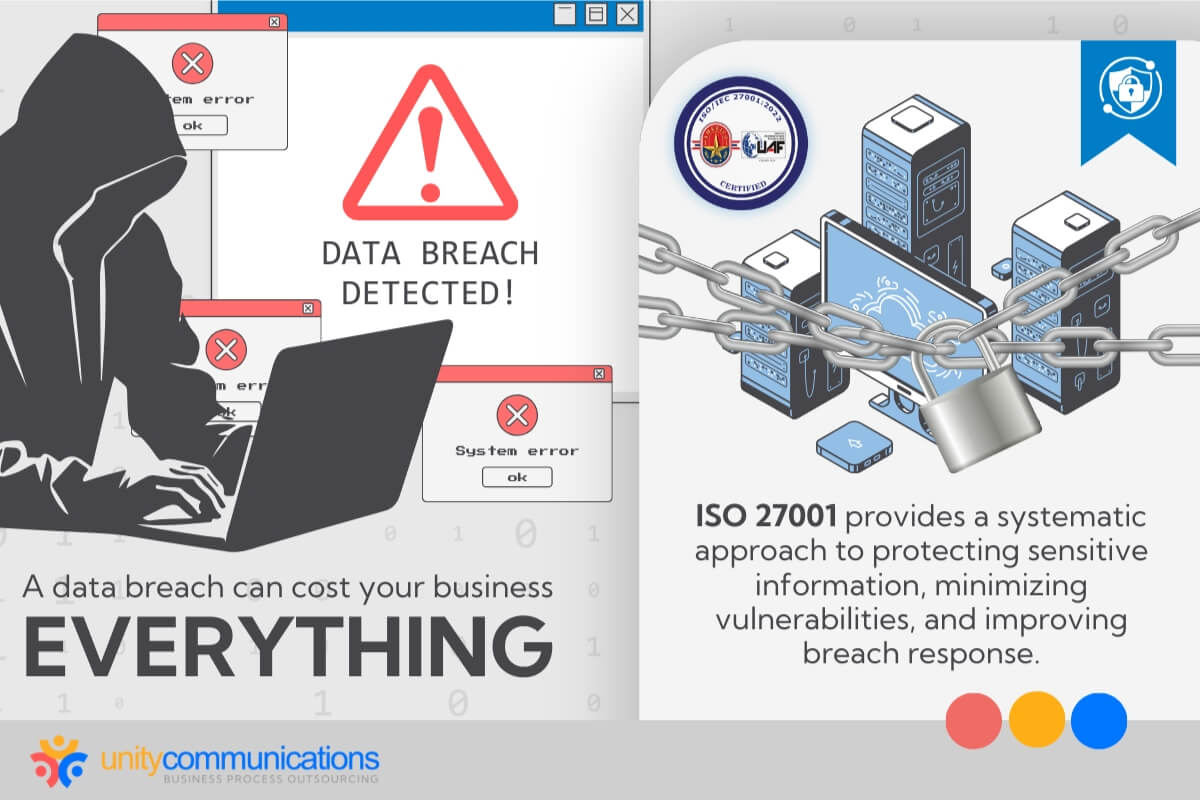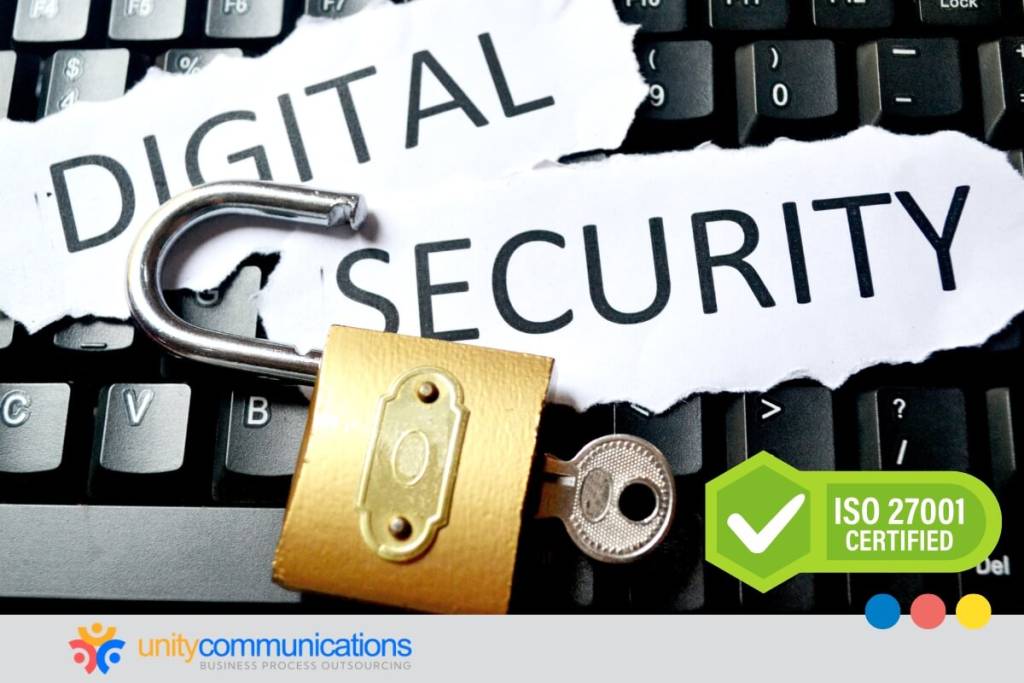Table of Contents
Data is the backbone of modern business operations. A single breach can lead to devastating financial and reputational consequences. Thus, robust security measures are essential.
ISO 27001 provides a globally recognized framework for safeguarding sensitive information. It helps organizations mitigate risks, achieve compliance, and build trust.
In this article, we’ll explore the significance of data security and ISO 27001 certification in building a competitive edge despite the rising online threats.
Understanding the importance of data security in the digital economy

With the popularity of remote work, e-commerce, cloud computing, and artificial intelligence (AI), the need for robust data security has never been greater. Cyber threats evolve rapidly, making businesses more vulnerable to breaches, data theft, and revenue loss.
The financial implications of escalating cyber warfare are staggering. Cybercrime Magazine reports that cybercrimes will cost the world $1 trillion monthly by 2031. Organizations that cannot implement stringent protections risk becoming a part of this alarming statistic.
As regulations tighten and consumers expect better online privacy, organizations must prioritize data security through standards such as ISO 27001 to help protect operations and maintain trust.
Data as the new currency
Data is one of the most valuable assets for modern businesses. It shapes decisions, fosters innovation, and enhances customer experience.
Companies collect vast sensitive data, including customer details, financial records, trade secrets, and operational insights. Losing control over this information can lead to significant financial and reputational damage.
Here are a few examples of data’s value:
- E-commerce. Online retailers collect data on customer browsing history, purchase patterns, and preferences. They use the information to recommend products, personalize marketing campaigns, and optimize their websites for better user experience.
- Healthcare. Hospitals and clinics maintain various patient data, including medical records, treatment plans, and health history. They are crucial for personalizing care, improving treatment outcomes, and conducting medical research.
- Finance. Banks and financial institutions use data to assess risk, detect fraud, and personalize financial advice. They analyze customer transactions, credit scores, and market trends to make informed decisions.
As industries digitize operations, ensuring data security is critical. It helps businesses maintain a competitive advantage and regulatory compliance.
The increasing cyber threats
Cyber Security Online (CSO) reports that cybercriminals are constantly developing new techniques.
The “Morris” worm infected over 6,000 computers in 1988. Then, in the late 1990s to early 2000s, hackers stole personal and financial data through the “ILOVEYOU” virus. In the 2010s, advanced persistent threats (APTs) invaded networks and stole confidential information for longer periods. One of the most well-known examples is the “WannaCry” ransomware that encrypted over 200,000 devices, restricting file access from their owners.
With artificial intelligence (AI) and machine learning (ML) tools proliferating in the 2020s, hackers have developed AI-powered attacks to speed up ransomware threats and find security weaknesses.
Infographic 1: The Evolving Cyber Threat Landscape
- A large icon for each “virus.”
- Beside each icon add the year in a large font.
- Below the year add the name of the virus.
- Below the name of the virus add a brief explanation.
Example:
- Morris Worm
- Icon: WORM
- Year: 1988
- Desc: Harmful malware that infected over 6,000 users.
- ILOVEYOU Virus
- Icon: Heart with ILY in the middle?
- Year: 1990s-2000s
- Desc: Malware that steals personal information
- WannaCry Ransomware
- Icon: A sad face with a tear to emphasize the “cry”
- Year: 2010s
- Desc: A ransomware that encrypted the files of over 200,000 computers.
- AI-Powered Attacks
- Icon: (no suggestions)
- Year: 2020s
- Desc: Speeds up ransomware attacks and finds security weaknesses.
Regulations and public expectations
With cyber threats escalating, governments and regulatory bodies worldwide have enacted stringent data security standards such as ISO 27001. Here are some of the most widely followed regulations that help curb cyber threats and protect consumers:
- The General Data Protection Regulation (GDPR) is a European Union law that gives individuals control over their data. It sets strict rules for organizations collecting or processing data and requires consent, security, and breach notification.
- The California Consumer Privacy Act (CCPA) gives consumers more control over their personal information, including the right to know, opt-out of sale, and request deletion. The law influences other U.S. states.
- The Health Insurance Portability and Accountability Act of 1996(HIPAA) is a U.S. law protecting the privacy and security of patient health information, setting standards for entities handling this data.
Consumers are also becoming more privacy-conscious, expecting businesses to handle their personal data responsibly. Companies that demonstrate strong data security measures can build trust, while those that suffer breaches often face legal consequences and brand damage.
Improving data security through ISO 27001

What is ISO 27001? It is an internationally recognized standard for information security management systems (ISMS). Developed by the International Organization for Standardization (ISO) and the International Electrotechnical Commission (IEC), it provides a systematic approach to managing sensitive information securely.
For any organization strengthening its data security framework, attaining the ISO 27001 certification is a significant milestone. It provides a structured approach to managing risks, complying with regulations, and protecting sensitive information from potential threats.
Here are the valuable ways ISO 27001 helps businesses strengthen data protection and security measures:
- Enhanced data protection
ISO 27001 is a holistic approach to data security that covers all information assets (digital, physical, and even knowledge-based). It assesses the risks to each and implements controls to mitigate those risks.
Here are some data security protocols the ISO 27001 standard implements:
- Access control: restricting data access to authorized personnel only (e.g., principle of least privilege, role-based access control, multi-factor authentication, access control lists, and regular access reviews)
- Encryption: protecting sensitive information through advanced encryption techniques (e.g., data-at-rest encryption, data-in-transit encryption, data-in-use encryption, and key management)
- Incident management: establishing response protocols to handle security breaches swiftly (e.g., incident response plan, designated incident response team, communication protocols, and post-incident review)
- Employee training: educating staff on cybersecurity best practices and awareness (e.g., phishing awareness training, password security training, data handling training, social engineering awareness training, and regular security awareness refreshers)
- Continuous monitoring: implementing real-time monitoring tools to detect potential threats (e.g., security information and event management systems, intrusion detection/prevention systems, endpoint detection and response, vulnerability scanning, and log management)
- Regular audits: conducting periodic security assessments for ongoing compliance (e.g., internal audits, external audits, penetration testing, and compliance audits)
These measures help businesses proactively defend against cyber threats and keep their data secure at all times.
Regulatory compliance
Many data security regulations share similar requirements with ISO 27001. Although the certification doesn’t guarantee compliance with each policy, it provides a strong foundation.
By implementing the ISO 27001 framework, organizations are already well on their way to meeting the requirements of these regulations. This simplifies the compliance process, reduces the effort required, and reduces the risk of hefty fines and legal repercussions for non-compliance.
Risk management
Risk assessment is a core component of ISO 27001. Organizations should systematically identify potential threats and vulnerabilities to their information assets. These include internal threats (such as employee error) and external threats (such as cyberattacks).
After identifying the risks, the organization must implement controls to mitigate or manage them. Controls can be:
- Technical (e.g., firewalls, encryption, access controls, and intrusion detection systems)
- Organizational (e.g., policies, procedures, training, and security awareness programs)
- Physical (e.g., locks, security cameras, access badges, and environmental controls)
This proactive approach to risk management allows businesses to prioritize their security efforts, focus on the most critical risks, and allocate resources effectively.
Building a competitive advantage through ISO 27001

Robust data security and ISO 27001 certification offer benefits that positively influence customer trust, operational efficiency, and business resilience. With cybersecurity as a key differentiator, organizations that demonstrate strong data protection practices gain an advantage over those that do not.
A business’s ISO 27001 certification signals to customers, partners, and other stakeholders that they take data security seriously. It’s an internationally recognized standard, so it shows credibility across borders and industries.
Additionally, ISO 27001 certification is not easy to achieve. It requires a significant investment of time, resources, and effort. It also involves an independent audit by a third-party organization to ensure objectivity. Hence, the certification exemplifies commitment to data security.
Here are more specific ways achieving an ISO 27001 certification gives businesses a competitive edge:
Standing out in a crowded market
Many invest in data security, but an ISO 27001 certification sets an organization apart. It might be a pre-requisite for large companies and government agencies. The same can be said about businesses that handle sensitive information daily such as finance, healthcare, and e-commerce.
One particular industry that requires robust data security measures is business process outsourcing (BPO). What is BPO? It is the practice of delegating non-core tasks, whether front-office or back-office, to an external team.
BPO providers handle highly sensitive data for their clients. That includes financial records, customer data, intellectual property, and even personal health information. A security breach in BPO operations can have devastating effects on the service provider and their clients. In some cases, it affects even their clients’ customers.
These consequences are why ISO-27001-certified BPO companies are more likely to be chosen by businesses that outsource. The ISO 27001 outlines some of the most essential data security measures BPO teams must implement.
Infographic 2: Data Security and ISO 27001 in the BPO Sector
- Create a circular flow infographic with five key sections arranged in a cycle. Each section should be linked with arrows, showing a continuous process.
Key sections:
- What Is BPO?
- Icon: Briefcase with arrows (representing outsourcing).
- Text: “Delegating front-office & back-office tasks to external teams.”
- Handling Sensitive Data
- Icon: Lock and document.
- Text: “BPO providers manage financial records, customer data, and intellectual property.”
- The Risk of Data Breaches
- Icon: Warning symbol with a network breach.
- Text: “A security breach impacts providers, clients & their customers.”
- The Role of ISO 27001
- Icon: Certification badge.
- Text: “ISO 27001 sets strict security guidelines for BPO operations.
- Why Businesses Choose ISO-27001-Certified BPO Companies
- Icon: Handshake and shield.
- Text: “Certified BPOs offer stronger data security & client trust.”
Fostering long-term customer loyalty
Customers are more likely to do business with companies they trust. A single data breach can lead to severe damage to this trust.
According to a report by Vercara, 75% of customers are willing to cut ties with brands prone to data breaches. This highlights the immense cost, both in finances and lost trust, that a data breach can inflict.
With ISO 27001, businesses can reassure clients that they can handle information securely. This fosters long-term loyalty and strengthens business relationships.
Proactively managing risks
Rather than reacting to data security threats after they occur, ISO 27001 encourages a proactive approach to risk management. By identifying vulnerabilities in advance and implementing preventative measures, businesses can reduce disruptions caused by security incidents.
Preventing security incidents is also far less expensive than dealing with the aftermath of a breach. Thus, ISO 27001’s proactive approach can lead to significant cost savings in the long run.
The bottom line
Data security is a top priority for businesses in today’s digital world. As cyber threats grow more frequent and sophisticated, organizations must take proactive measures to protect sensitive information.
ISO 27001 provides a structured framework for managing cybersecurity risks, ensuring compliance, and building trust. For companies committed to data security, getting the ISO 27001 certification is a smart investment.
By achieving ISO 27001 certification, Unity Communications has reinforced its position as a trusted leader in the BPO industry. Let’s connect and discuss how we can help safeguard your business.




